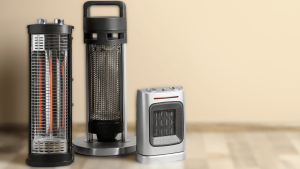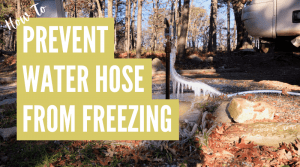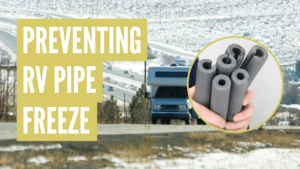Camper FAQs is reader-supported. Buying through links on our site may earn us an affiliate commission. As an Amazon Associate I earn from qualifying purchases.
No matter how well-insulated your camper is, it can get downright cold inside in the winter months (and even cold spring and fall nights).
Even if you have a built-in furnace, you may still want an electric heater for several reasons:
- To provide extra heat in extreme cold
- To heat certain areas of the RV, for example, the bedroom
- To save on propane
- And so on!
Below we help you find the best electric heater for RV use by comparing and reviewing the top 3 models on the market today.
Note: I highly advise you to read the post “Are Space Heaters Safe to Use in RVs?” before operating an electric heater in your RV.
1. Heat Storm Phoenix Infrared Space Heater
- Best Overall

Heat Storm HS-1500-PHX-WIFI Infrared Heater, Wifi Wall Mounted
$124.99
Last updated: November 24, 2025I use a Heat Storm space heater and love it. Some are wall mountable, which can save space, but I have one with feet. I even use it in my basement when I’m at home, and it keeps our entire living area down there nice and warm. Had it for 7 years now.
Tory Jon
The Heat Storm’s Phoenix Space Heater provides up to 5200 BTUs of heating power, enough to warm up any RV interior. And thanks to its patented HMS technology, the Phoenix also safely produces this heat without affecting a room’s humidity and oxygen levels.
Whether adjusting the heat output or monitoring the temperature, this heater’s touch control interface and LED display are easy to use and understand. It also comes with a remote control for extra convenience.
You can opt to attach the Phoenix to your RV’s walls or on the floor, which is a huge plus, in my opinion. If you have small kids or just want to save precious floor space in your camper, hanging it is a great option. No matter how you decide to install it, installation is hassle-free and requires no special tools.
Lastly, the heater’s infrared heating technology is extremely energy-efficient, allowing you to enjoy the comforts of a warm RV without a significant rise in electricity costs.
Key Features
- Streamlined interface with remote control, touch display, and Wi-Fi smart feature.
- Safe and efficient infrared heating with patented HMS technology.
- Versatile and convenient installation with wall-mounting functions and removable feet
Specifications
- Maximum Heat Output: 5200 BTUs
- Heating Type: Radiant heating
- Dimensions: 18.75 x 4.5 x 12.75 inches
- Weight: 8 pounds
Pros
- Convenient temperature control features
- Safety features (ETL Safety Certified)
- Light and portable frame
- Instantaneous installation
- Noise-free heating
Cons
- Heat output can fluctuate occasionally

Heat Storm HS-1500-PHX-WIFI Infrared Heater, Wifi Wall Mounted
$124.99
Buy on AmazonLast updated: November 24, 20252. Caframo Limited True North Space Heater
- Best Value
I have the Caframo space heater. The way its designed it can’t be tipped over. It has adjustable thermostat, overheat protection, all that good stuff. I’ve had it for five years and would buy it again if it stopped working tomorrow.
terry.miller

Caframo True North Heater. Low Profile, Quiet, Powerful Heater for Work and Hom…
$101.05
Last updated: November 24, 2025If you’re looking for the perfect split between quality and affordability, Caframo’s True North Heater is an excellent choice. This model is capable of producing up to 5200 BTUs using forced-air heating.
The heater is compact enough to fit in smaller spaces, and its unique shape makes it impossible to tip over accidentally. Don’t be fooled by its size though: the True North Heater’s durable solid steel frame is built to last.
It is also jam-packed with useful features like easy-access temperature controls and a built-in thermostat. For settings, you can switch between fan only, heat, and anti-freeze. The latter is incredibly convenient because the unit turns on automatically when the temperature drops to 38oF.
Key Features
- A built-in thermostat makes for easy temperature adjustment and regulation
- Five different settings to adjust the fan speed and heat output
- Dual overheat protection
- Five-year warranty
Specifications
- Maximum Heat Output: 5118 BTUs
- Heating Type: Forced Air
- Dimensions: 9.25 x 4.4 x 4.4 inches
- Weight: 5.25 pounds
Pros
- Convenient anti-freeze setting
- Good heat output
- Five-year warranty
- Durable frame
Cons
- Fans might be too noisy for some

Caframo True North Heater. Low Profile, Quiet, Powerful Heater for Work and Hom…
$101.05
Buy on AmazonLast updated: November 24, 20253. Lasko Ceramic Portable Space Heater
- Best Budget

Lasko CD09250 Ceramic Adjustable Thermostat Tabletop or Under-Desk Heater, 9 In…
$31.19
Last updated: November 24, 2025Despite being the most compact model in our list, the Lasko Space Heater remains a strong contender. With a small, light frame and an integrated carry handle, this portable heater is especially convenient for the frequent traveler. Regulating the temperature is also a breeze with its multiple settings and adjustable thermostat.
Because it uses ceramic heating, the Lasko Space Heater remains silent even under maximum output. The exterior remains cool even if you run it on the highest setting, so you don’t have to worry about getting burnt. This unit also has overheating protection that maintains safe temperatures even if left on for extended periods.
This heater is a reliable option if you’re on a tight budget but still want a quality model. You also don’t have to worry about costly repairs or replacements any time soon because every Lasko Space heater comes with a generous three-year warranty.
Key Features
- Adjustable thermostat with a heat dial to change the temperature to your liking
- Multiple settings that adjust the fan speed and heat output
- Ceramic heating provides quiet and efficient performance
- Light and compact frame, combined with a convenient carry handle, enhances portability
- Built-in safety features prevent the unit from overheating
Specifications
- Maximum Heat Output: 5118 BTU
- Heating Type: Ceramic Heating
- Dimensions: 5.7 x 3.7 x 9 inches
- Weight: 3.5 pounds
Pros
- Simple control interface
- Quiet and efficient heating
- Affordable
Cons
- No remote control

Lasko CD09250 Ceramic Adjustable Thermostat Tabletop or Under-Desk Heater, 9 In…
$31.19
Buy on AmazonLast updated: November 24, 2025Features To Look For In An RV Heater
Heating Capacity
Heating capacity should be at the top of your considerations when getting an electric heater for RV use. A unit may have many quality features but is virtually useless if it can’t provide sufficient heating.
BTUs and watts are the most common units used to determine heating power. Higher numbers equate to better heating capacities. Most brands will provide both of these units to better showcase the effectiveness of their heaters. Maximum wattages and BTUs of 1500 and 5000, respectively, are often enough to warm up most RVs.
Safety
Safety should also be among your top priorities, especially for heat-producing appliances. A faulty heater can damage your RV and potentially cause physical harm. I recommend investing in a quality model with built-in safety features.
To prevent a mishap, many heaters come with overheating protection, cool-down times, and automatic shut-downs. To be on the safe side, I recommend that you never leave a powered heater unattended. Always turn it off when you leave the RV and before going to sleep.
Portability
A heavy and bulky heater has no place in a typical RV setting. You want a unit that is light and compact. Some heaters also come with handles to make transport easier.
With that said, bigger units usually provide more power. Depending on your needs, you may want to sacrifice a bit on portability in exchange for better heating.
Convenience
Electric heaters can come with many useful additions, like built-in thermostats and multiple temperature settings. While not strictly necessary, these features might be worth the extra cost if you want a convenient and efficient unit.
For instance, you can get a heater with a remote control function, allowing you to change settings with the touch of a button. Some models can detect the surrounding temperature and automatically turn it on when it gets too cold.
Power Consumption
Powerful heaters are more resource-heavy. They can take a toll on your trip’s budget if you’re not careful. For this reason, I recommend that you factor in the consumption rate when purchasing a heater.
As mentioned, some heaters (like radiant or oil) are more energy-efficient than others. In the long run, investing in a pricier model with more efficient heating might save you more.
Durability
Many RV trips involve going over bumpy and uneven roads. These continuous shocks and vibrations can easily damage a flimsy heater. You don’t have to worry about needing expensive repairs or replacements with a quality unit anytime soon.
You should always factor in a model’s design and materials to help you assess its durability. Another way to gauge the integrity of a heater is its warranty. A generous, long-lasting warranty conveys the manufacturer’s confidence in a model’s durability and gives you the confidence of safe operation.
Other Factors To Consider
Aside from its features, many other factors can influence what type of heater will suit your needs best:
The Size Of Your RV
The bigger your RV’s interior, the harder it is to heat up. To compensate for the larger space, you need an equally powerful heater that can provide ample warmth.
Use the size of your vehicle to gauge what level of heating makes the best fit. As mentioned, a 5000-BTU heater is usually enough to heat most RV interiors.
How Insulated Is Your RV
Like your home, you want to ensure your RV is well insulated to hold in the heat produced by your heater, or all is for naught.
A well-insulated camper will be easier to heat and keep warm in winter than one that is not insulated properly. And it may be able to do that with a much smaller, more energy-efficient heater.
If your vehicle could use a little insulation help, check out our guide on how to insulate a camper for winter use.
Existing RV Heating Components
Electric heaters provide instant and localized heat that can be useful in many situations.
Even if your RV has built-in heating, you might need an extra heater when the temperature drops down too much, or you need a source for localized heat, like in your bedroom.
Traveling Conditions
If you mainly travel during colder weather, you need a heater with enough BTUs to keep your RV warm. Conversely, getting a lower-powered heater can save you some money if you often go camping in areas with temperate or warmer climates.
A regular electric heater also dries up the surrounding air. Low-moisture air can cause dried skin, cracked lips, and even headaches. If traveling in drier conditions, you might want to bring a humidifier to improve the air quality.
On the other hand, too much moisture in the air can cause condensation issues that can lead to damage. Or worse yet, mold issues. Unlike a propane heater, an electric heater can help warm up your camper without adding moisture to the air. In other words, it can provide ample heat while keeping moisture out of your RV.
Your Budget
You don’t have to shell out the big bucks to get a good heater. If you do not need built-in Wi-Fi, remote control functions, and other extra additions, you can find many affordable options that will last a long time.
Conversely, you might want to save up for a pricier option with these convenient features.







Write a comment